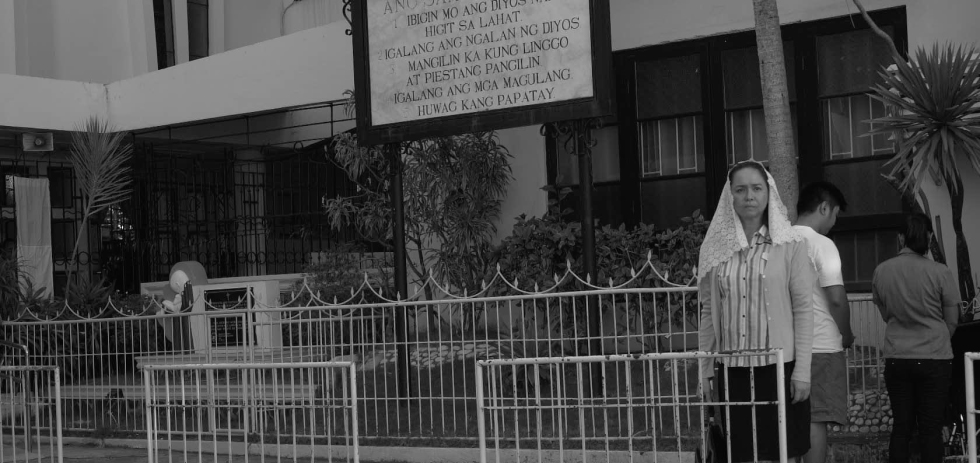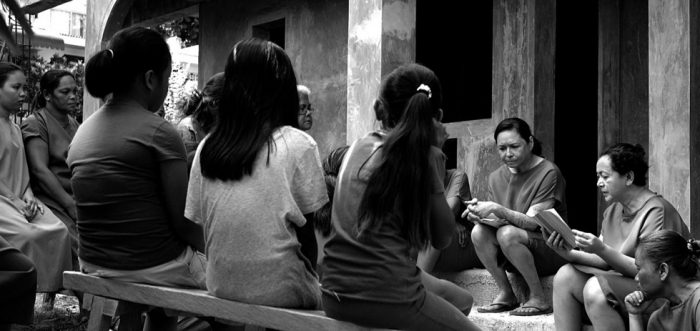
Ivan Dmitrich Aksionov, the protagonist in Leo Tolstoy’s 1872 short story God Sees the Truth, But Waits, spends 26 years exiled in Siberia as punishment for a crime he never committed. In his time there he turns to God, with Tolstoy’s story centring itself around a process of forgiveness. For his latest film, The Woman Who Left, Lav Diaz draws on elements of Tolstoy’s short story, with clear and acknowledged parallels. Horacia Somorostro (Charo Santos-Concio) finds herself suddenly released from a Women’s Correctional Facility after 30 years: her friend has committed suicide, leaving a note taking responsibility for for the crime Somorostro committed1 Diaz, like Tolstoy, maintains a focus on the role of religion, namely Catholicism, which Diaz explores in relation to the poor communities, the injustices they endure, against the wealthier institutional form, portrayed as serving the wealthier figures that feed the inequality depicted throughout.2 There are limits to what Diaz’ work can faithfully take from Tolstoy’s. It results in pointedly stark reflections on how faith manifests itself in a society where forgiveness is overridden by a desire of justice inextricably tied to revenge.
At 228 minutes long, The Woman Who Left doesn’t even scrape into the top ten when ranking Diaz’ films by length.3 As a result, there’s a pronounced and comparatively fast-paced narrative that feels particularly uncharacteristic of his work. There’s an ease to which he adapts to a different rhythm, though, shifting his contemplative directing style to a more precise focus – on studying the characters at the center of his work. Diaz maps out an emotional cartography, using the protagonists of The Woman Who Left as microcosms to reflect a larger portrait of the downtrodden, underclass and outcast figures within the Philippines.
Horacia is established as a hardened figure, defined by a pure sense of generosity that draws her to other ill-treated people. After her release, she moves to the town where the wealthy Rodrigo Trinidad—responsible for masterminding her framing 30 years earlier—resides. Her purpose is clear: to take revenge. Over the course of The Woman Who Left, this plan unravels. As Horacia gets closer in taking out Trinidad, she becomes equally invested in the lives of those within the poverty-stricken neighbourhood. Horacia first encounters Hollanda (John Lloyd Cruz) as a cross-dressing stranger, having an epileptic seizure on the street. Both characters are defined as outcasts rejected by a society far less morally righteous than themselves; their friendship emerges from this shared sense of exclusion.
While Tolstoy’s short story offers up the broad premise of The Woman Who Left, its influence is sidelined as the film’s runtime marches on, as Diaz’ breadth of influences and concerns make themselves much more pronounced. The literature of Russia has operated both as an overt and subtle influence on Diaz’ work. With 2014’s Norte, The End of History, the director delivered a thorough adaptation of Dostoevsky’s Crime and Punishment. In The Woman Who Left, Diaz’s influences collide with one another in a more organic manner than the more strictly adaptive Norte. In the run-down outskirts of town, where Diaz’ aforementioned leads meet, there are echoes of the discontent felt throughout Maxim Gorky’s 1902 much-adapted play, The Lower Depths, which focuses on a group of downtrodden Russians grouped together in a shelter, meditating on the sense of hopelessness that defines their lives.4 Still, Gorky allows a certain resilience amongst the depiction of destitution in his work, injecting a specific social dynamic to Tolstoy and Dostoesvky’s earlier conception of realist fiction from decades earlier. Hollanda’s epilepsy and sexuality renders him a pariah, akin to Prince Myshkin from Dostoevsky’s The Idiot. 5 While both Myshkin and Hollanda offer a moral compass within their contexts, neither Russian nobility nor Filipino plutocracy are concerned enough with morality to accept them.
When Horacia describes herself as “a creature of the dark”, she articulates a similar exclusion to Hollanda—and throughout The Woman Who Left, both characters are most commonly shot in amidst darkness, in Diaz’s trademark use of black-and-white. There’s an aesthetic questioning by Diaz, of Horacia’s statement. When we see Rodrigo Trinidad giving a half-hearted confession in church, he’s doused in bright, almost overexposed whites and he is, by any visual assessment, a creature of the light,sustained by the suffering of those we see left in the dark.

There are very few scenes in which Rodrigo Trinidad appears on screen, and while there’s an argument to be made for decentring such a character, an even longer film would’ve explored out the intricacies of his corruption and even commented on what drives his actions. Still, the approach Diaz brings to framing time and space in his films allows him to draw a wealth of meaning and insight from every conversation that we do see on screen, unexpected and natural layers of humanity bubble to the surface long after the point at which most filmmakers would call cut. In one winding take, towards the end of the film, this approach results in one of the director’s most remarkable scenes to date. It’s hard to recall the length of some scenes in a Diaz film, where what feels like a couple of minutes could have been half-an-hour, or vice-versa. The emotional crescendo of The Woman Who Left in Horacia and Hollanda’s final shared scene is marked by exactly this temporal blurring. As the two take turns singing a cappella renditions of classic songs—West Side Story‘s “Someday”, for instance—they drift between peaks of intimacy, honesty, anger, frustration, and resolve. As difficult to describe as any of Diaz’s most sensorily breathtaking scenes, it exists in impermanence; operating as both a self-contained act and also an integral component of his wide-reaching narrative.
The film’s denouement offers more of a bitter ache than a resolution. At one point, earlier on, we hear a character ask: “I heard they’ll demolish this place. What about those that are living there now? Where will they go? Where will they live?” When that demolition finally comes, Diaz lets the camera linger on the destruction, as a group of forklifts tear down each house, the images are matched by cries of anguish from the unseen villagers. Diaz ultimately offers no answers to these earlier questions.We see Horacia one last time, venturing out from a makeshift shelter to fulfil her titular role.t’s not a pleasant end but it offers an image that simmers long after the closing credits.
Diaz has long been the figurehead of the New Philippine cinema, but with The Woman Who Left, he’s continuing to expand his legacy outside of the country, and beyond the increasingly reductive ‘slow cinema’ label. Diaz has always been a sociopolitical filmmaker: from the fallout of Typhoon Yolanda in Storm Children, the rising spectre of Ferdinand Marcos in From What is Before, the cycle of poverty in Evolution of a Filipino Family, to the reflection on the disappearances that occurred throughout the Marcos regime in Melancholia. The Woman Who Left operates with the same concerns; attacking inequity and rigid societal structures, whilst reengaging and adapting older moralistic notions. Diaz does this with a trimmer runtime than usual, and while that may not entirely please longstanding fans of the director, the result is one of his most accessible films to date; a reliable entry point to a dense filmography and one of the strongest works of Diaz’s career.
